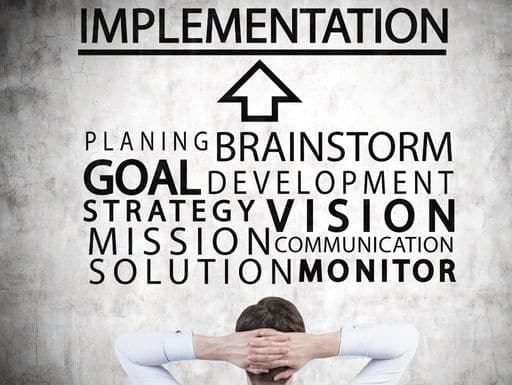The 5-Step Group Problem-Solving Process

One of the more challenging leadership skills is getting a group to work together on a common problem. However, a group of individuals can be more creative and productive than any one person alone.
The key is to keep the team focused throughout the process. You also want to make sure that the process doesn’t devolve into a popularity contest. For instance, let’s say that one of the team leaders comes up with a great solution. However, this team leader has a rival who leads another team. As a result, the rival team leader offers a different solution.
The process can quickly change from determining a solution based on merit to one based on persuasion. Each team leader will try to win the group to his or her side. So, an effective group problem solving process should be objective. It should also use the strengths of the entire team versus just one or two outspoken leaders.
Effective Group Problem Solving Techniques Needs to Utilize the Strengths of the Whole Group.
Perception is reality. Our experiences, successes, failures, and beliefs all create filters for our perception. If we perceive that facts are true based on our experience, we tend to hold onto these perceptions even when faced with refutable proof to the contrary.
For example, a child, who has no experience with dogs, tries to pet a neighborhood dog at the park. The dog growls, barks, and eventually bites the child. The child’s experience with dogs could create a perception that ALL dogs are mean or temper mental.
That single experience creates a filter or paradigm in the mind of the child. This paradigm clouds the person’s perception of reality. To that person, you can try to prove that most dogs are nice and loyal. But the argument may fall on deaf ears.
We all have these perceptions. Some work for us in a positive way and some are negative. For instance, when you bite into a piping hot pizza and singe the roof of your mouth, you learn something. You will, most likey, blow on the next bite to cool it before doing it again.
The point is that the sum of our experiences make us who we are. My experience is totally different from yours. As a result, my paradigms — my filters — are totally different as well.

Since We All Have Different Filters, Groups of People Are More Likely to Identify Unique Solutions.
A single person trying to solve a problem is more difficult than an entire team working on the same problem. Each person has different experiences. For instance, 20 years ago, if someone requested information from our website, they filled out a form. The form sent an email directly to our sales team and the administrative team as well. Over the years, we have added great apps like Slack and a great CRM.
However, since we started out using email decades ago, it is still there as well. I hired a VP of sales last year. The first thing he said was, “Holy cow! Why am I getting 1000 emails every day?” It was an obvious problem that we had overlooked for years. Since he was new, though, he had an entirely different paradigm. The solution was obvious. (Stop sending all the stupid, repetitive emails.)
The filter (paradigm) that you look through depends on your perspective. For instance, let’s say you are standing in the middle of a field and next to you is a curved wall. Is the wall convex or concave? The answer is, it depends on what side of the wall that you are on. Both answers are correct. For instance, if you are standing on the concave side, it would be hard to convince you the wall was convex. However, if people from each side of the wall describe it to you, you will have a more clear picture of reality.
This is the value of Group Problem Solving. The group is more likely to identify a real and unique solution.
The 5-Step Group Problem-Solving Process.
Once you have a diverse team established, the 5-step group problem-solving process works really well. The key to success, though, is to make sure you go through each step in the process. If you skip any step, the process quickly falls apart.
Step #1: Identify the Specific Problem and Create a One-Sentence Description.
This step sounds easy, but it is actually the most difficult and the most critical step as well. If your problem statement is too vague, then you will likely struggle with trying to come up with valid solutions. Also, if the problem statement is too encompassing, then a solution might be too complex to easily implement.
For example, if we decide that the problem we want to overcome is poor customer service, then the group is likely to spend countless hours trying to first define customer service. More time will be spent coming up with every solution under the sun to try to fix the vague problem. The success of the solution would also be hard to measure. However, if we broke customer service into more specific parts, solutions are easier. For instance, if we want to increase the satisfaction level of our call center agents, that is easier. Or if we want to increase repeat sales from existing customers, solutions are easier to come by.
Step #2: What are the Possibly Causes

Take some time to identify what some of the root causes of the problem are, and your team will come up with solutions to these root causes much more quickly.
By the way, this is the step that most people skip. We come up with a good problem statement and jump right to the solution. If you don’t try to figure out what caused the problem in the first place, it will be more difficult to determine what the best solution is.
Step #3: What are the Possible Solutions
If you have a nice list of possible causes, all you have to do is state one possible cause. Then, ask the team, “How can we fix that cause?” These mini-solutions come quickly. In fact, once the root causes are uncovered, solutions should start popping like popcorn. As soon as one team member states a possible solution, another team member will “hitchhike” another idea. Initially, you may get a bunch of similar solutions.
If you see this happening, just move onto another possible cause and try to identify solutions to that root cause. The most important part of this process is to try to not pre-judge any solution. The quantity of ideas is more important than the quality of the idea at this point. Try to get as many ideas on the table as possible. The more the merrier.
Step #4: What’s the Best Possible Solution
In this step, you’ll want to weigh the pros and cons of each solution to determine what is the best plan of action based on what we know today. You may find that halfway through the implementation that one of the other solutions might work better. It’s okay to regroup and begin to implement another solution if the first “Best Possible Solution” turns out to be a poor choice after all. Don’t be afraid to take risks, though. Be willing to go out on a limb to create a breakthrough.
Here are a couple of easy ways to judge what solution is best. The easiest way is to look at your list of root causes and determine what solution fixes the most of them. In some situations, the best solution will be obvious. In other cases, you might look for the “path of least resistance.” Some possible solutions may be no-cost and easy. You might want to start with those. If they work, then you just saved a lot of time and money. If they don’t go back to your list of possible solutions and try another.
Step #5: Create an Implementation Plan
Most problem-solving meetings end when the solution is determined. Don’t fall into this trap though. Once the solution is decided upon, create a detailed plan of action that hold specific people accountable for implementation. By doing this, you ensure that the solution that you worked so hard for actually pays off for you and your company.
You have to make sure that once you come up with a fantastic solution, you have to implement the solution. Otherwise, you have wasted the entire process.
So if you want to tackle a huge problem follow these steps. First, identify a specific problem that can be solved. Next, identify a few of the possible root causes. Then, try to come up with a few possible solutions. Finally, identify the best of the solutions and implement it.
